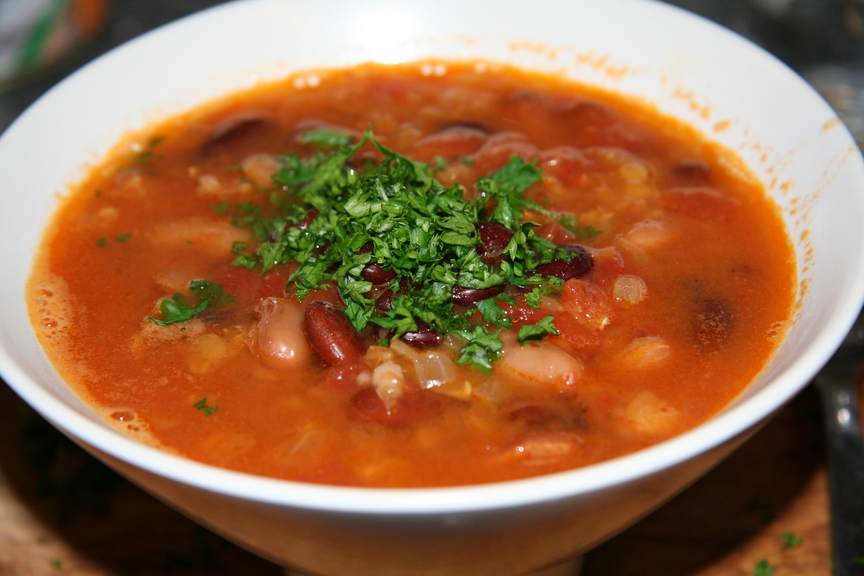I decided at first to make fruit smoothies in the morning and vegetable juice in the afternoon, using enough varied ingredients to cover all the diet goals. After one day of juicing vegetables I changed my plans from juicing to making soups. The advantage of juicing is getting nutrients into your body the fastest way possible, an important goal for detoxing, but not for brain health. Indeed, some of the antioxidants in vegetables become more effective with heat, while including vegetable fiber in your diet promotes intestinal health, which in turn has been shown to help brain health.
With this simplistic approach to a balanced diet in place I developed two recipes that make life easy enough for any house husband. To make things even simpler I refrain from providing exact recipes, while either smoothies or soups are perfect for adding whatever additional ingredients suits your fancy. Here are my recipes for both Brain Smoothie and Brain Soup.
Brain Smoothie
Put in about 6 ounces of kefir, a liquid yogurt blend that provides the probiotic component for a healthy microbiome diet. Add one banana, a prebiotic food, blueberries for their supreme antioxidant value and one citrus fruit for a low glycemic touch. All fruits have nutrients, add one of whichever fruit you desire to round out your smoothie, for us that’s usually an apple. Add cinnamon, a good spice for brain health, according to taste and then blend. This makes at least enough for two 12-ounce fruit smoothies.
Alternatives: Instead of kefir use a couple spoonfuls of greek yogurt and add some fruit juice void of cane sugar and high fructose corn syrup for the right consistency. Tart cherry juice is your best bet to be void of these problem ingredients.
Brain Soup
In a medium pot prepare one cup of whole grain brown rice (with water added will make closer to three cups). The whole grain brown rice provides a healthy starch filler for the soup.
In a large soup pot saute some colorful, non-leafy vegetables, such as carrots and/or peppers, in a couple tablespoons of extra virgin olive oil. If not using meat for the soup, this one uses lentils as its main source of B vitamins, also saute one medium olive and a few garlic cloves. The olive oil provides fatty acids that can be broken down into ketones while the colorful vegetables are good anti-inflammatory and low glycemic foods. The garlic is good for, well, just about everything related to your health.
Add two quarts of organic chicken stock and one quart of tomato juice to the sauteed veggies, then add one 12-ounce bag of lentils as your source of B vitamins. Bring to a boil and let simmer for at least 45 minutes. Continue to simmer as much as you would like for a thicker soup. Add kale, sage, curry, ginger and black pepper to the soup and let simmer a little while longer. I use ¼ teaspoon of each spice for each quart of stock used, and use fresh kale and sage leaves. Kale is another vegetable that is both anti-inflammatory and low glycemic. Curry contains turmeric, probably the best brain spice out there, along with some other healthy spices. Ginger is probably the second best brain spice. Black pepper, while also healthy, is mainly for taste.
Alternatives: For meat soups use organic chicken or grass fed beef. Saute the meat along with the onion and garlic cloves separately then add to the soup after having added the stock. For starch you could use whole grain pasta or sweet potatoes, if using potatoes saute them first along with the colorful vegetables. You can use parsley as an herb instead of sage. Parsley provides more general all around nutritional value while sage provides more targeted brain health nutrition.
Added tips: Anywhere you see bay leave in a recipe you could use parsley or sage instead for a distinct flavor with better nutritional value. The spices and herbs I use for soup I also use for spaghetti sauce, both to the satisfaction of folks who have tried either.
The amount of soup I make at a time provides at least 4 meals for the both of us. Between that and the smoothies I’ve developed a very convenient, lazy-man’s approach to an extremely healthy diet for the brain.

